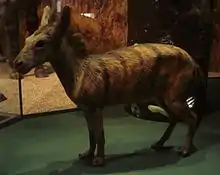Sifrhippus
Sifrhippus is an extinct genus of equid containing the species S. sandrae and S. grangeri. Sifrhippus is the oldest known equid, living during the early Eocene.[1] Its fossils were discovered in the Bighorn Basin of Wyoming.[2][3] A 2012 study found Arenahippus to be synonymous with Sifrhippus.[4]
| Sifrhippus | |
|---|---|
 | |
| Sifrhippus restoration in the Swedish Museum of Natural History | |
| Scientific classification | |
| Kingdom: | Animalia |
| Phylum: | Chordata |
| Class: | Mammalia |
| Order: | Perissodactyla |
| Family: | Equidae |
| Genus: | †Sifrhippus Froehlich, 2002 |
| Species | |
| |
| Synonyms | |
| |
Description
Sifrhippus looked similar to modern horses, but were more slender and much smaller. Individuals likely weighed between 8.5–12 pounds (3.9–5.4 kg); the size variance, according to one theory, depended on the warmth of the climate.[2][5]
Taxonomy
Sifrhippus sandrae is referred to in earlier literature as Hyracotherium sandrae, but Froehlich, arguing that the traditional genus Hyracotherium was not monophyletic, reassigned many of its species to other genera. Froehlich gave H. sandrae the new generic name Sifrhippus, derived from the Arabic صِفْر (ṣifr), "zero", and Greek ἵππος (híppos), "horse".[3]
Since Froehlich's reorganization of Hyracotherium based on the morphological differences between fossil specimens, further study has suggested that all nine taxa derived from the original definition of Hyracotherium are invalid.[6] It has been argued that the differences in the fossils are more likely caused by individual variation in animals. Based on this hypothesis, Sifrhippus would be an invalid taxon.
References
- "†Sifrhippus Froehlich 2002 (horse)". Retrieved 6 August 2019.
- Gingerich, P.D. (1989). "New earliest Wasatchian mammalian fauna from the Eocene of northwestern Wyoming: composition and diversity in a rarely sampled high-floodplain assemblage". University of Michigan Papers on Paleontology. 28: 1–97. hdl:2027.42/48628.
- Froehlich, D.J. (2002). "Quo vadis eohippus? The systematics and taxonomy of the early Eocene equids (Perissodactyla)". Zoological Journal of the Linnean Society. 134 (2): 141–256. doi:10.1046/j.1096-3642.2002.00005.x.
- Secord, R.; Bloch, J. I.; Chester, S. G. B.; Boyer, D. M.; Wood, A. R.; Wing, S. L.; Kraus, M. J.; McInerney, F. A.; Krigbaum, J. (2012). "Evolution of the Earliest Horses Driven by Climate Change in the Paleocene-Eocene Thermal Maximum". Science. 335 (6071): 959–962. doi:10.1126/science.1213859. PMID 22363006.
- Gorman, James (23 February 2012). "A Tiny Horse That Got Even Tinier as the Planet Heated Up". The New York Times.
- Rej, J.E.; Lucas, S.G. (April 2015). "Analysis of morphological differences between two early Eocene horses: Minippus jicarillai of New Mexico and Sifrhippus sandrae of Wyoming". New Mexico Geological Society.